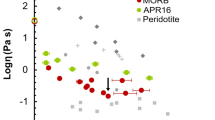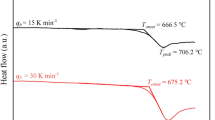Abstract.
Water dissolved in a silicate melt can strongly influence its physical properties and thus magma behavior during crystallization, degassing, foaming and fragmentation. Etna is a basaltic volcano whose activity is dominated by effusive eruptions which have long represented a threat to the densely populated, surrounding area. Recently, recognition of the products of a Plinian eruption (122 B.C.) has raised further issues for hazard assessment at Etna and other basaltic volcanoes. Constraining the behavior of Etna magma under conditions relevant to both effusive and explosive hazards requires viscosity data under conditions near the glass transition. Here we have investigated the viscosity of hydrous Etna lava in order to better understand eruptive processes which characterize this volcano. The experimental methods which have been used include piston cylinder synthesis of the hydrated melts, micropenetration viscometry for low-temperature viscosity measurements, and near-infrared spectroscopy for the evaluation of sample homogeneity and measurements of water content. Additionally, scanning calorimetric determinations were performed to check whether incipient crystallization had occurred. Sample compositions were determined using electron microprobe analysis and 57Fe Mössbauer spectroscopy. Results from this study are compared with previous reports of trachytic, phonolitic and model calc-alkaline rhyolite (HPG8) compositions. The viscosity of the basaltic melt (dry and wet) has been parameterized in terms of temperature and water content via the non-Arrhenian equation: log10 η=–4.643+(5,812.44–427.04×H2O)/(T(K)–499.31+28.74×ln(H2O)) where η is the viscosity in Pa s, H2O is the water content in wt%, and T is the temperature in Kelvin. We observe that the viscosity of alkali basalt (at more than 0.5 wt% H2O) is similar to that of an alkaline trachyte (Agnano–Monte Spina eruption, Phlegrean Fields) and much higher than that of a peralkaline phonolite (Teide, Tenerife) at similar silica contents and NBO/T. For water contents above 1.5 wt%, the viscosity of the basalt is similar to that of rhyolitic melts with similar water contents. At temperatures ranging from 1,050 to 1,150 °C and with water contents between 0.5 and 2.3 wt% (eruptive conditions), the viscosities calculated using the equation defined in this study are (1) in reasonable agreement with those calculated using Shaw's model, and (2) much lower than those experimentally determined in a previous study. However, outside these temperature and water content ranges, the agreement with Shaw's model (1972) breaks down.
Similar content being viewed by others
Author information
Authors and Affiliations
Additional information
Electronic Publication
Rights and permissions
About this article
Cite this article
Giordano, D., Dingwell, D. Viscosity of hydrous Etna basalt: implications for Plinian-style basaltic eruptions. Bull Volcanol 65, 8–14 (2003). https://doi.org/10.1007/s00445-002-0233-2
Received:
Accepted:
Published:
Issue Date:
DOI: https://doi.org/10.1007/s00445-002-0233-2




